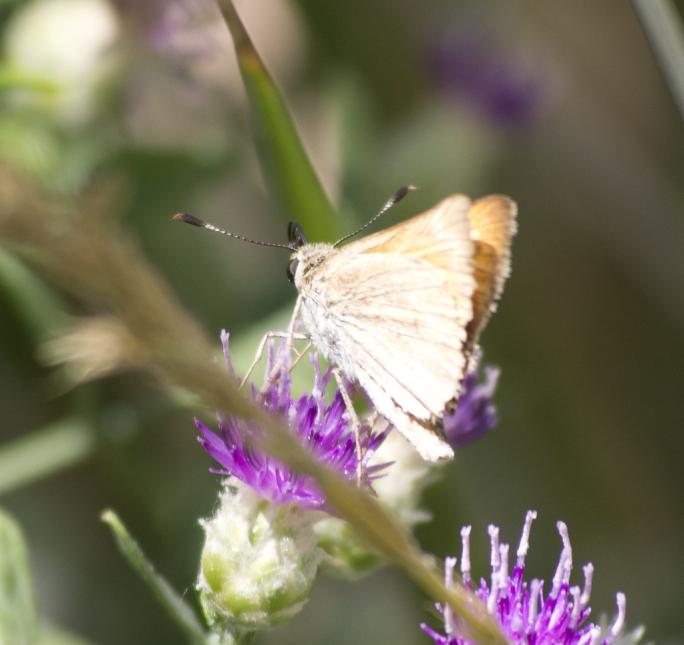Moderate
The population of the Yuma skipper in Washington is critical and is considered to have a declining trend. This butterfly is recognized as "Species of Greatest Conservation Need" throughout its range due to the small number of isolated populations, specialized and restricted habitat, and known threats to its habitat. Research is needed to more accurately quantify specific habitat requirements including vegetation structure, food plant size and density, and key habitat features.
Description and Range
Physical description
The Yuma skipper is a small butterfly; its wingspan is a little over one inch in size.
Ecology and life history
The native common reed (Phragmites americanus) is the known hostplant for the Yuma skipper, which is limited to a few marshes in the xeric Columbia Basin steppe. Hostplants feed caterpillars (larvae). To date, this butterfly has not been found in stands of the invasive, non-native common reed, although further surveys are needed to address this potential. Beyond their need for the native species of common reed, little is known of their habitat requirements. Their primary nectar plants are unknown.
These skippers complete a single life cycle annually (univoltine). They are sedentary butterflies and do not migrate; instead, the species inhabits sites year-round (as egg, larva, pupa and adult), typically moving within only a few hundred meters of their natal locations.
Adults emerge from their chrysalids (pupae) during June through July. Males begin emergence first, followed by females; late-season individuals are primarily or solely females. Weather influences butterfly emergence and the flight period duration, with wet or cold conditions delaying emergence.
Both males and females feed by using their long proboscis to sip floral nectar.
Male skippers seek mates by perching on low vegetation and then darting out to inspect passing butterflies. Males that detect females commence courtship behavior; when males detect another male they engage in a territory defense behavior of tight, upward spiraling flight.
Females search for egg-laying sites by slowly flying and hovering just above hostplant vegetation and then depositing single eggs.
Skipper larvae conceal themselves in silken shelters and primarily feed at night. Yuma skippers are members of the Hesperiinae subfamily, whose larvae create shelters formed by webbing their hostplant grass blades together, and their prepupal larvae construct strong silken shelters in hostplant grasses in which pupation occurs. The Yuma skipper overwinter as larvae.
Geographic range
Overall, the range of the Yuma skipper is highly disjunct; the butterfly is found in the Columbia Basin in Washington, southeast Oregon, eastern Central California, Nevada, southern Utah, eastern Colorado, and northern Arizona. In Washington, Yuma skippers occur in a few small, isolated populations.
For a map of range-wide distribution and conservation status of the Yuma skipper, check out NatureServe Explorer.
Climate vulnerability
Sensitivity to climate change
Moderate
Yuma skipper occupies reed beds around freshwater marshes, wetlands, streams, and other wet areas, and is likely sensitive to increasingly dry conditions that may affect the distribution and persistence of its larval host plant, the common reed. However common reed is fairly resilient, as it is able to persist for several years in dried-out wetlands; therefore, habitat for Yuma skipper may be resilient to short-term drought, but could be vulnerable to long-term drought and/or significant shifts in surface water delivery to wetland areas. Further, the extremely limited distribution of Yuma skipper in Washington makes it vulnerable to local extirpation.
Exposure to climate change
Moderate
- Altered flow regimes
- Prolonged drought
Conservation
Conservation Threats and Actions Needed
- Management decision needs
- Threat: State Parks and other land managers are not aware that native Phragmites exists and is the host for this butterfly, so they often attempt to treat Phragmites as a weed
- Action Needed: Develop management plans specific to occupied sites
- Resource information collection needs
- Threat: Lack of data on current status and distribution
- Action Needed: Determine distribution and population status
See the Climate vulnerability section above for more information about the threat posed by climate change to this species.
Resources
References
James, D. and D. Nunnallee. 2011. Life Histories of Cascadia Butterflies. Oregon State University Press, Corvallis. 447pp.
Pyle, R.M. and C.C. LaBar. 2018. Butterflies of the Pacific Northwest. Timber Press. 461 pp.
Pyle, R. 2002. The Butterflies of Cascadia. Seattle Audubon Society. Seattle, WA. 420 pp.
Pyle, R. 1989. Washington butterfly conservation status report and plan. Washington Department of Fish and Wildlife, Olympia. 216 pp.
